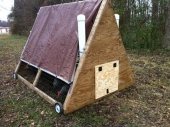
 1
1




"Our society is run by insane people for insane objectives.... I think we’re being run by maniacs for maniacal ends ... and I think I’m liable to be put away as insane for expressing that. That’s what’s insane about it." - John Lennon, Interview BBC-TV (June 22, 1968)




Tim Southwell
www.abcacres.com
www.facebook.com/abcacres
Youtube: ABC acres
 4
4




Tim Southwell
www.abcacres.com
www.facebook.com/abcacres
Youtube: ABC acres




"Our society is run by insane people for insane objectives.... I think we’re being run by maniacs for maniacal ends ... and I think I’m liable to be put away as insane for expressing that. That’s what’s insane about it." - John Lennon, Interview BBC-TV (June 22, 1968)




"Our society is run by insane people for insane objectives.... I think we’re being run by maniacs for maniacal ends ... and I think I’m liable to be put away as insane for expressing that. That’s what’s insane about it." - John Lennon, Interview BBC-TV (June 22, 1968)




"Our society is run by insane people for insane objectives.... I think we’re being run by maniacs for maniacal ends ... and I think I’m liable to be put away as insane for expressing that. That’s what’s insane about it." - John Lennon, Interview BBC-TV (June 22, 1968)




Francis Oublieux wrote:Found this on you tube tonight, and it fits pretty well with my thoughts on a permanent paddock operation, though even smaller than my own. Wish he would have mentioned how many chickens and what size the paddocks are... but makes me think I am headed in the right direction.
http://www.youtube.com/watch?v=06H9Z-ri3E4




Tim Southwell
www.abcacres.com
www.facebook.com/abcacres
Youtube: ABC acres




"Our society is run by insane people for insane objectives.... I think we’re being run by maniacs for maniacal ends ... and I think I’m liable to be put away as insane for expressing that. That’s what’s insane about it." - John Lennon, Interview BBC-TV (June 22, 1968)




"Our society is run by insane people for insane objectives.... I think we’re being run by maniacs for maniacal ends ... and I think I’m liable to be put away as insane for expressing that. That’s what’s insane about it." - John Lennon, Interview BBC-TV (June 22, 1968)




Thanks from a new member! Though I cannot currently have chickens (motel property, health regulations blah blah blah) I have my eyes on the near future, wherein I will be able to do it all! Huge organic garden, flock of hens, maybe even a couple nanny goats.Tim Southwell wrote:You might want to check out this book, 'Free Range Chickens, How to create a beautiful chicken friendly yard', by Bloom. It is well put together, going through breeds, coop design, how many and what to feed, beneficial plantings for feeding, health and security, etc. Also, I am taking a Poultry Production course through Cornell's online Beginning Farmers program. I have some interesting PDF's I could share with you... like these...
Good luck...

My fellow citizens, we live in a great nation. It's occasional resemblance to a
lunatic asylum is purely coincidental and doubtlessly not the intention of the author of us all.
- Molly Ivins, 1944 - 2007









Paul Cereghino- Ecosystem Guild
Maritime Temperate Coniferous Rainforest - Mild Wet Winter, Dry Summer




"Our society is run by insane people for insane objectives.... I think we’re being run by maniacs for maniacal ends ... and I think I’m liable to be put away as insane for expressing that. That’s what’s insane about it." - John Lennon, Interview BBC-TV (June 22, 1968)





"You must be the change you want to see in the world." "First they ignore you, then they laugh at you, then they fight you, then you win." --Mahatma Gandhi
"Preach the Gospel always, and if necessary, use words." --Francis of Assisi.
"Family farms work when the whole family works the farm." -- Adam Klaus




"Our society is run by insane people for insane objectives.... I think we’re being run by maniacs for maniacal ends ... and I think I’m liable to be put away as insane for expressing that. That’s what’s insane about it." - John Lennon, Interview BBC-TV (June 22, 1968)










